Study on Improving Electrochemical Machining Performances through Energy Conversion of Electrolyte Fluid
Abstract
:1. Introduction
2. Methodology
3. Experiment Preparation
4. Results and Discussions
4.1. Regulation of Dynamic Pressure and Static Pressure in the Electrolyte Channel
4.2. Effect of Fluid Energy Conversion on Surface Morphology of ECM
4.3. Effect of Fluid Energy Conversion on MRR of ECM
4.4. Effect of Fluid Energy Conversion on Machining Performance under Different Current Densities
5. Conclusions
- The simulation results show that the dynamic pressure energy and static pressure energy of the electrolyte fluid can be effectively adjusted by changing the degree of convergence of the electrolyte outlet. Moreover, higher dynamic pressure energy can be obtained by sacrificing dynamic pressure energy, which may bring positive effects in terms of ECM performance.
- The experimental results obtained with different degrees of convergence of the electrolyte outlet show that moderate energy conversion of electrolyte fluid can achieve better surface quality and MRR. However, excessive sacrifice of fluid dynamic pressure energy will also worsen ECM performance.
- The experimental results obtained under constant-current conditions show that the voltage increment in the convergent flow mode is smaller than that in the normal outlet mode. This may be because in the convergent flow mode, the static pressure of the electrolyte can effectively compress the gas product volume and reduce the resistivity of the machining gap.
- Comprehensive simulation and experimental results indicate that the moderate energy conversion of electrolyte fluid can not only achieve better machining performance but also improve the utilization efficiency of electrical energy in the ECM process.
Author Contributions
Funding
Institutional Review Board Statement
Informed Consent Statement
Data Availability Statement
Conflicts of Interest
References
- Rajurkar, K.P.; Zhu, D.; McGeough, J.A.; Kozak, J.; De Silva, A. New developments in electro-chemical machining. CIRP Ann. Manuf. Technol. 1999, 48, 567–579. [Google Scholar] [CrossRef]
- Geethapriyan, T.; Muthuramalingam, T.; Palani, I.A.; Mani, J.; Nikolaos, E.K.; Emmanouil, L.P.; Panagiotis, K.O. Influence of Silver-Coated Tool Electrode on Electrochemical Micromachining of Incoloy 825. Coatings 2023, 13, 963. [Google Scholar] [CrossRef]
- Xu, Z.Y.; Wang, Y.D. Electrochemical machining of complex components of aero-engines: Developments, trends, and technological advances. Chin. J. Aeronaut. 2019, 34, 28–53. [Google Scholar] [CrossRef]
- Sharma, V.; Patel, D.S.; Jain, V.K.; Ramkumar, J. Wire electrochemical micromachining: An overview. Int. J. Mach. Tools Manuf. 2020, 155, 103579. [Google Scholar] [CrossRef]
- Zhan, S.D.; Liu, Z.Z.; Dong, B.Y.; Liu, W.D.; Zhao, Y.H. Cathodic discharge plasma in electrochemical jet machining: Phenomena, mechanism and characteristics. Int. J. Mach. Tools Manuf. 2023, 187, 104015. [Google Scholar] [CrossRef]
- Klocke, F.; Zeis, M.; Klink, A.; Veselovac, D. Experimental research on the electrochemical machining of modern titanium- and nickel-based alloys for aero engine components. Procedia CIRP 2013, 6, 368. [Google Scholar] [CrossRef]
- Chen, Y.L.; Zhou, X.C.; Chen, P.X.; Wang, Z.Q. Electrochemical machining gap prediction with multi-physics coupling model based on two-phase turbulence flow. Chin. J. Aeronaut. 2020, 33, 1057–1063. [Google Scholar] [CrossRef]
- Lin, J.; Zhu, D.; Hu, X. Flow field design and experimental investigation of the electrochemical trepanning of a diffuser with a liquid-increasing seam. Int. J. Adv. Manuf. Technol. 2021, 112, 2533–2545. [Google Scholar] [CrossRef]
- Liang, H.; Yan, C.; Zhang, X.Y.; Zhang, J.H.; Lei, Y.; Li, Y.; Fan, Q.M. Research on the multi-physics field coupling simulation of aero-rotor blade electrochemical machining. Sci. Rep. 2021, 11, 2817. [Google Scholar]
- Ge, Y.C.; Zhu, Z.W.; Ma, Z.; Wang, D.Y. Large allowance electrochemical turning of revolving parts using a universal cylindrical electrode. J. Mater. Process. Technol. 2018, 258, 89–96. [Google Scholar] [CrossRef]
- Xu, Z.Y.; Sun, L.Y.; Hu, Y.; Zhang, J.C. Flow field design and experimental investigation of electrochemical machining on blisk cascade passage. Int. J. Adv. Manuf. Technol. 2014, 71, 459–469. [Google Scholar] [CrossRef]
- Zhu, D.; Zhu, D.; Xu, Z.Y.; Xu, Q.; Liu, J. Investigation on the flow field of W-shape electrolyte flow mode in electrochemical machining. J. Appl. Electrochem. 2010, 40, 525–532. [Google Scholar] [CrossRef]
- Gu, Z.Z.; Zhu, D.; Xue, T.Y.; Liu, A.; Zhu, D. Investigation on flow field in electrochemical trepanning of aero engine diffuser. Int. J. Adv. Manuf. Technol. 2017, 89, 877–884. [Google Scholar] [CrossRef]
- Zhu, D.; Gu, Z.Z.; Xue, T.Y.; Zhu, D. Flow Field Design in Electrochemical Machining of Diffuser. Procedia CIRP 2016, 42, 121–124. [Google Scholar] [CrossRef]
- Wang, Y.D.; Xu, Z.Y.; Liu, J.; Zhang, A.; Xu, Z.L.; Meng, D.M.; Zhao, J.B. Study on flow field of electrochemical machining for large size blade. Int. J. Mech. Sci. 2021, 190, 106018. [Google Scholar] [CrossRef]
- Li, H.S.; Wang, G.Q.; Qu, N.S.; Zhu, D. Through-mask electrochemical machining of a large-area hole array in a serpentine flow channel. Int. J. Mach. Tools Manuf. 2016, 89, 933–940. [Google Scholar] [CrossRef]
- Liu, Y.; Liu, J.; Zhu, D. Flow field optimization of pulse dynamic electrochemical machining for serpentine channels on stainless steel plates. Int. J. Adv. Manuf. Technol. 2023, 129, 3563–3576. [Google Scholar] [CrossRef]
- Tang, L.; Yang, F.; Gan, W.M. Electrochemical machining flow field simulation and experimental verification for irregular vortex paths of a closed integer impeller. Int. J. Adv. Manuf. Technol. 2016, 83, 275–283. [Google Scholar] [CrossRef]
- Liu, Y.; Qu, N.S. Improvements to machining surface quality by controlling the flow direction of electrolyte during electrochemical sinking and milling of titanium alloy. Sci. China Technol. Sci. 2020, 63, 2698–2708. [Google Scholar] [CrossRef]
- Yang, F.; Zhang, J.; Zhao, S.; Guo, C.A. Analysis of flow field for electrochemical machining deep spiral hole with gradually changing groove section. Int. J. Adv. Manuf. Technol. 2020, 107, 3267–3275. [Google Scholar] [CrossRef]
- Ge, Y.C.; Zhu, Z.W.; Ma, Z.; Wang, D.Y. Tool Design and Experimental Study on Electrochemical Turning of Nickel-Based Cast Superalloy. J. Electrochem. Soc. 2018, 165, E162–E170. [Google Scholar] [CrossRef]
- Zou, X.H.; Fang, X.L.; Zeng, Y.B.; Zhu, D. A high efficiency approach for wire electrochemical micromachining using cutting edge tools. Int. J. Adv. Manuf. Technol. 2017, 91, 3943–3952. [Google Scholar]
- Jia, J.L.; Hao, Y.J.; Ma, B.J.; Xu, T.C.; Li, S.C.; Xu, J.; Zhong, L. Gas–liquid two-phase flow field analysis of two processing teeth spiral incremental cathode for the deep special-shaped hole in ECM. Int. J. Adv. Manuf. Technol. 2023, 127, 5831–5846. [Google Scholar] [CrossRef]
- Tang, L.; Ma, Y.C.; Xue, R.R.; Bo, Y.F.; Zhang, J.J.; Zhang, j. Optimization and experimental study on cathode structure of electrochemical machining titanium alloy inner helix. Int. J. Adv. Manuf. Technol. 2024, 130, 1141–1149. [Google Scholar] [CrossRef]
- Chai, M.X.; Li, Z.Y.; Yan, H.J.; Huang, Z.X. Flow field characteristics analysis of interelectrode gap in electrochemical machining of film cooling holes. Int. J. Adv. Manuf. Technol. 2021, 112, 525–536. [Google Scholar] [CrossRef]
- Shin, H.S.; Kin, B.H.; Chu, C.N. Analysis of the side gap resulting from micro electrochemical machining with a tungsten wire and ultrashort voltage pulses. J. Micromechanics Microengineering 2008, 18, 75009. [Google Scholar] [CrossRef]
- Fang, X.L.; Qu, N.S.; Zhang, Y.D.; Xu, Z.Y.; Zhu, D. Effects of pulsating electrolyte flow in electrochemical machining. J. Mater. Process. Technol. 2014, 214, 36–43. [Google Scholar] [CrossRef]
- Qu, N.S.; Hu, Y.; Zhu, D.; Xu, Z.Y. Electrochemical machining of blisk channels with progressive-pressure electrolyte flow. Mater. Manuf. Process. 2014, 29, 572–578. [Google Scholar] [CrossRef]
- Hu, X.Y.; Zhu, D.; Li, J.B.; Gu, Z.Z. Flow field research on electrochemical machining with gas film insulation. J. Mater. Process. Technol. 2019, 267, 247–256. [Google Scholar] [CrossRef]
- Hewidy, M.S.; Ebeid, S.J.; Rajurkar, K.P.; El-Safti, M.F. Electrochemical machining under orbital motion conditions. J. Mater. Process. Technol. 2001, 109, 339–346. [Google Scholar] [CrossRef]
- Zhao, R.C.; Huang, L.; Zhao, H.Y.; Cao, Y.; Tian, W.J.; Wang, N. Study of Mask Electrochemical Machining for Ring Narrow Groove under the Action of Multiple Physical Fields. Coatings 2022, 12, 605. [Google Scholar] [CrossRef]
- Cao, W.J.; Wang, D.Y.; Guo, H.T.; Zhu, D. Improvement on profile accuracy of convex structure during counter-rotating electrochemical machining by periodically changing electrolyte flow direction. J. Manuf. Process. 2023, 102, 79–94. [Google Scholar] [CrossRef]
- Xu, J.W.; Zhu, D.; Lin, J.H.; Hu, X.Y. Flow field design and experimental investigation of electrochemical trepanning of diffuser with a special structure. Int. J. Adv. Manuf. Technol. 2020, 107, 1551–1558. [Google Scholar] [CrossRef]
- Ge, Z.H.; Chen, W.W.; Zhu, Y.W. Simulation and Experimental Study on Improving Electrochemical Machining Stability of Highly Convex Structures on Casing Surfaces Using Backwater Pressure. Chin. J. Mech. Eng. 2021, 35, 98. [Google Scholar] [CrossRef]
- Wang, G.Q.; Jiang, S.; Ni, S.D.; Zhang, Y. Study of Mass Transfer Enhancement of Electrolyte Flow Field by Rotating Cathode in Through-Mask Electrochemical Micromachining. Micromachines 2023, 14, 1398. [Google Scholar] [CrossRef] [PubMed]
- Wang, Y.D.; Xu, Z.Y.; Meng, D.; Liu, L.; Fang, Z.D. Multi-Physical Field Coupling Simulation and Experiments with Pulse Electrochemical Machining of Large Size TiAl Intermetallic Blade. Metals 2023, 13, 985. [Google Scholar] [CrossRef]
- Subbaiah, T.; Vijetha, P.; Marandi, B.; Sanjay, K.; Manickam, M. Ionic Mass Transfer at Point Electrodes Located at Cathode Support Plate in an Electrorefining Cell in Presence of Rectangular Turbulent Promoters. Sustainability 2022, 14, 880. [Google Scholar] [CrossRef]
- Sarangi, C.K.; Sheik, A.R.; Marandi, B.; Ponnam, V.; Ghoshet, M.K.; Sanjay, K.; Minakshi, M.; Subbaiah, T. Recovery of Tellurium from Waste Anode Slime Containing High Copper and High Tellurium of Copper Refineries. Sustainability 2023, 15, 11919. [Google Scholar] [CrossRef]


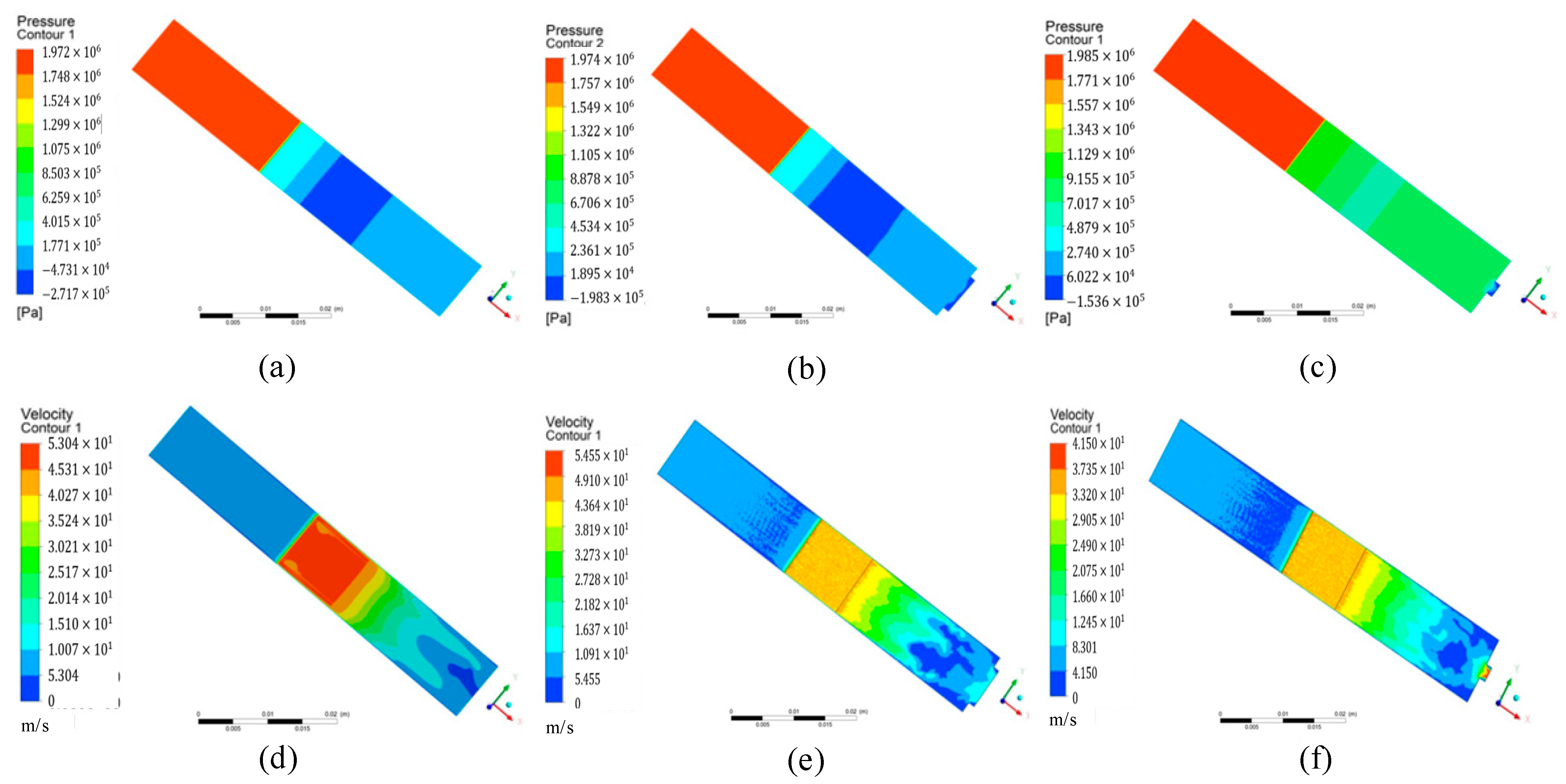
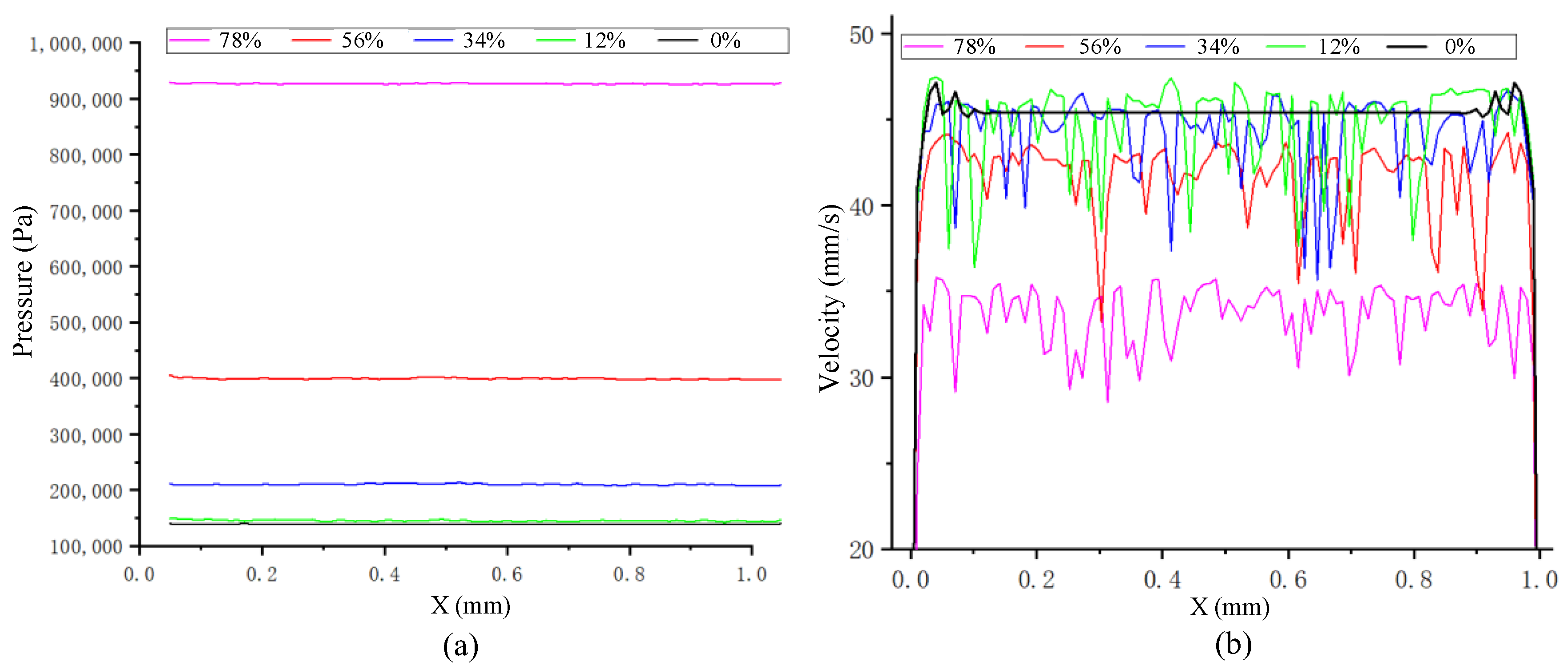


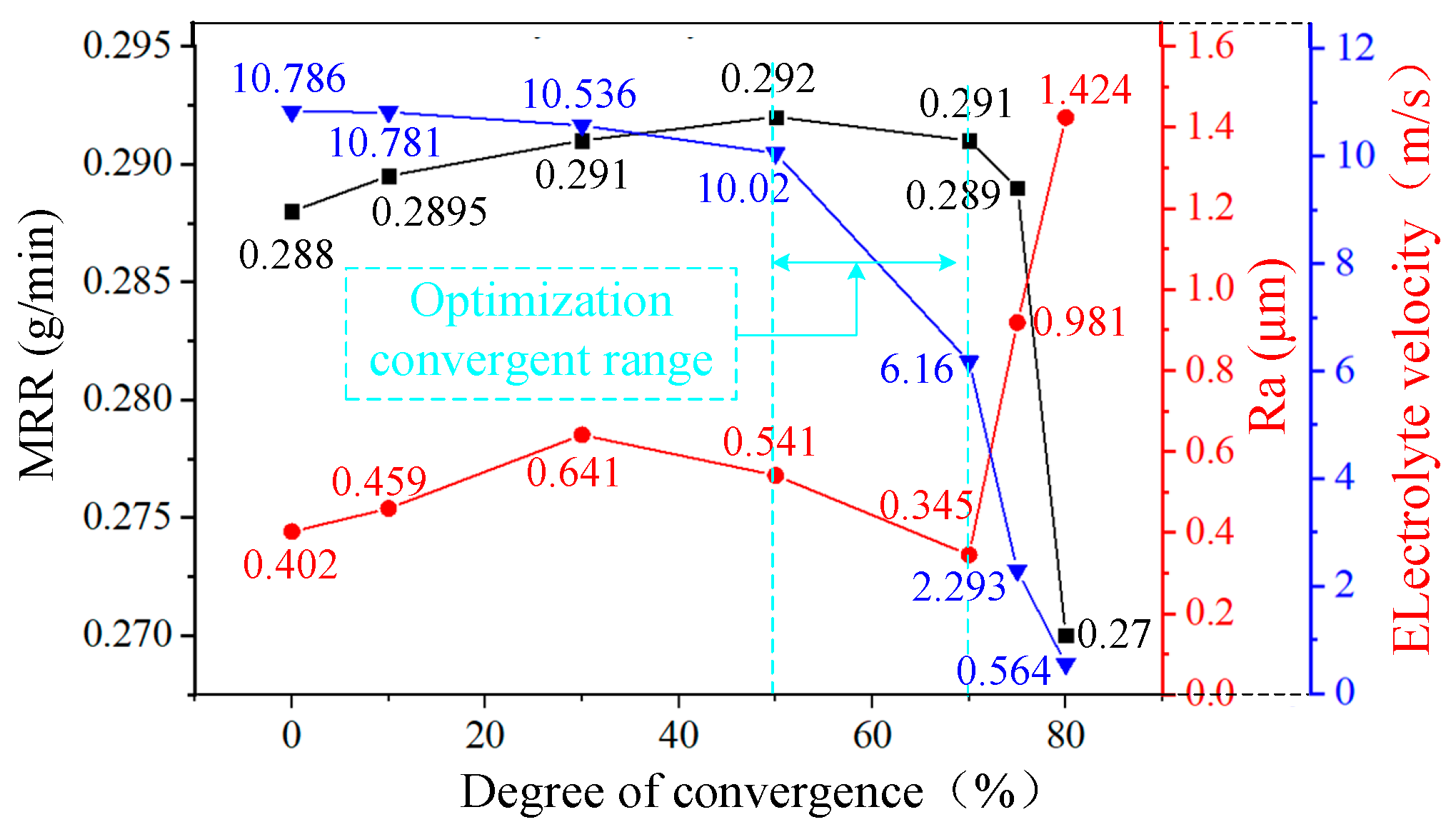
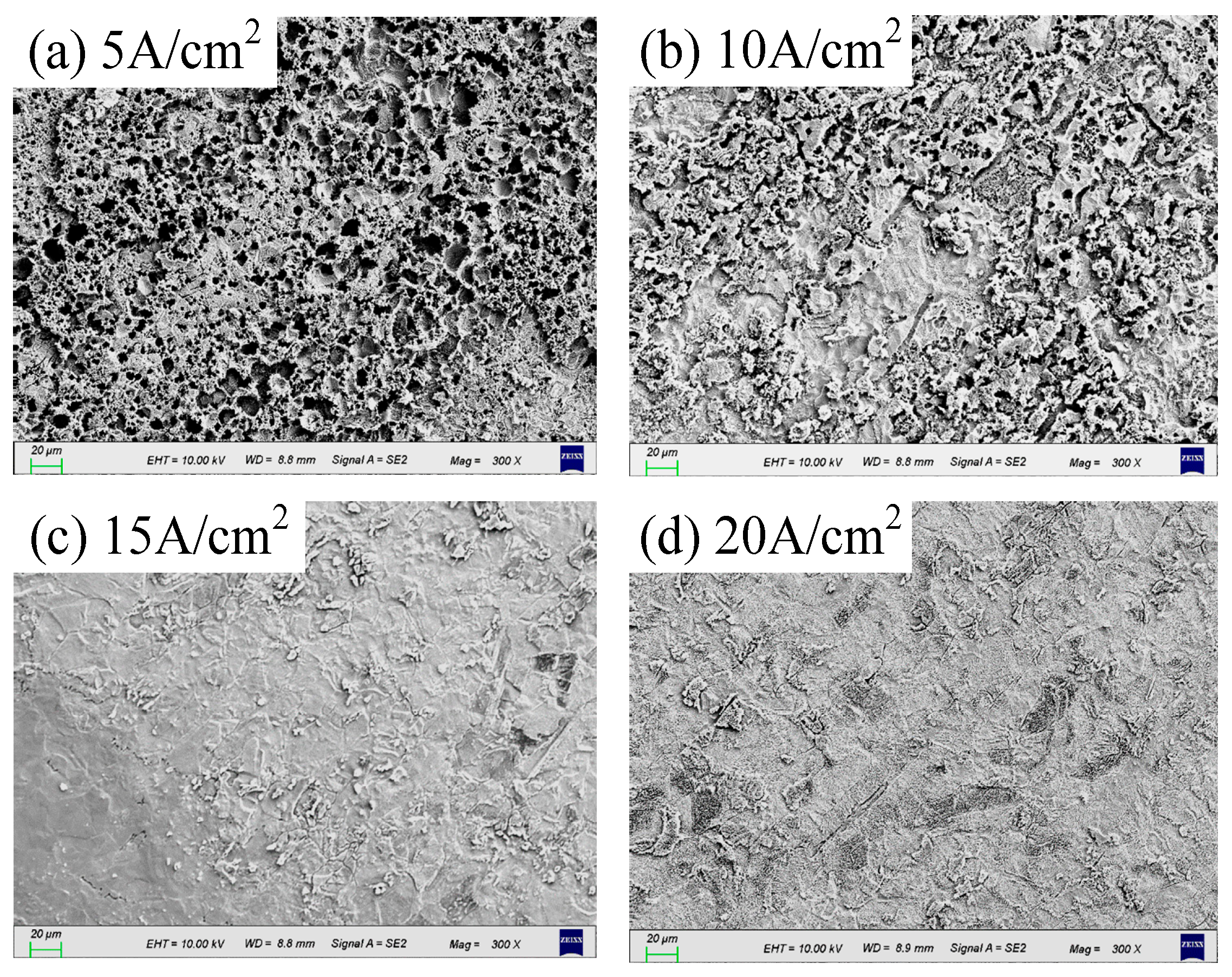
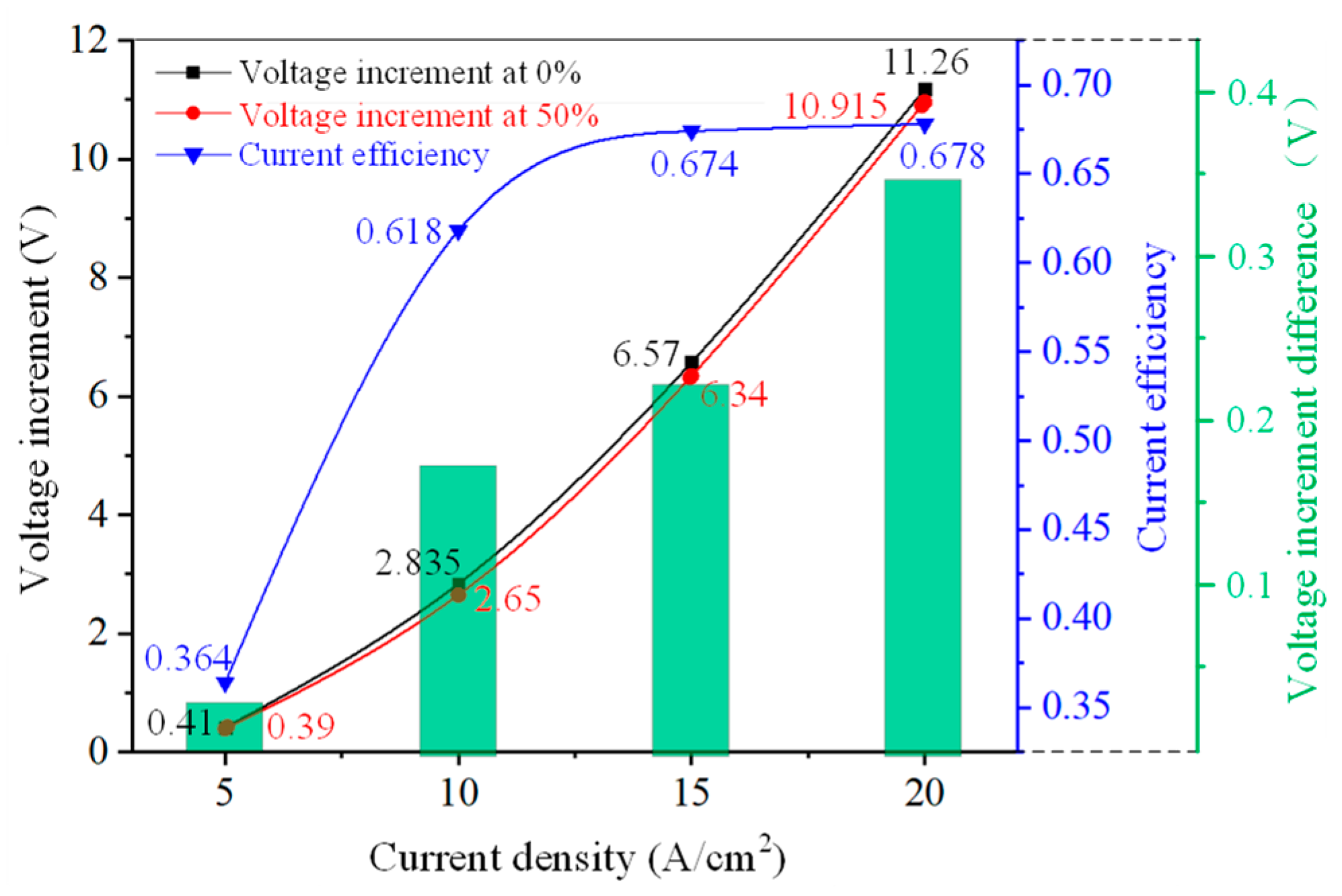
| Parameter | Value |
|---|---|
| Workpiece material | Stainless steel |
| Cathode material | Stainless steel |
| Electrolyte inlet pressure (MPa) | 0.04 MPa |
| Degree of convergence | From 0% to 78% |
| Electrolyte | 10% NaNO3 |
| Electrolyte temperature (°C) | 25 |
| Fe | Ni | Cr | C | Si | Mn |
|---|---|---|---|---|---|
| Balance | 8.92 | 18.38 | 0.08 | 1.00 | 2.00 |
Disclaimer/Publisher’s Note: The statements, opinions and data contained in all publications are solely those of the individual author(s) and contributor(s) and not of MDPI and/or the editor(s). MDPI and/or the editor(s) disclaim responsibility for any injury to people or property resulting from any ideas, methods, instructions or products referred to in the content. |
© 2024 by the authors. Licensee MDPI, Basel, Switzerland. This article is an open access article distributed under the terms and conditions of the Creative Commons Attribution (CC BY) license (https://creativecommons.org/licenses/by/4.0/).
Share and Cite
Ge, Z.; Chen, M.; Chen, W.; Zhu, Y. Study on Improving Electrochemical Machining Performances through Energy Conversion of Electrolyte Fluid. Coatings 2024, 14, 406. https://doi.org/10.3390/coatings14040406
Ge Z, Chen M, Chen W, Zhu Y. Study on Improving Electrochemical Machining Performances through Energy Conversion of Electrolyte Fluid. Coatings. 2024; 14(4):406. https://doi.org/10.3390/coatings14040406
Chicago/Turabian StyleGe, Zhenghui, Maolong Chen, Wangwang Chen, and Yongwei Zhu. 2024. "Study on Improving Electrochemical Machining Performances through Energy Conversion of Electrolyte Fluid" Coatings 14, no. 4: 406. https://doi.org/10.3390/coatings14040406




